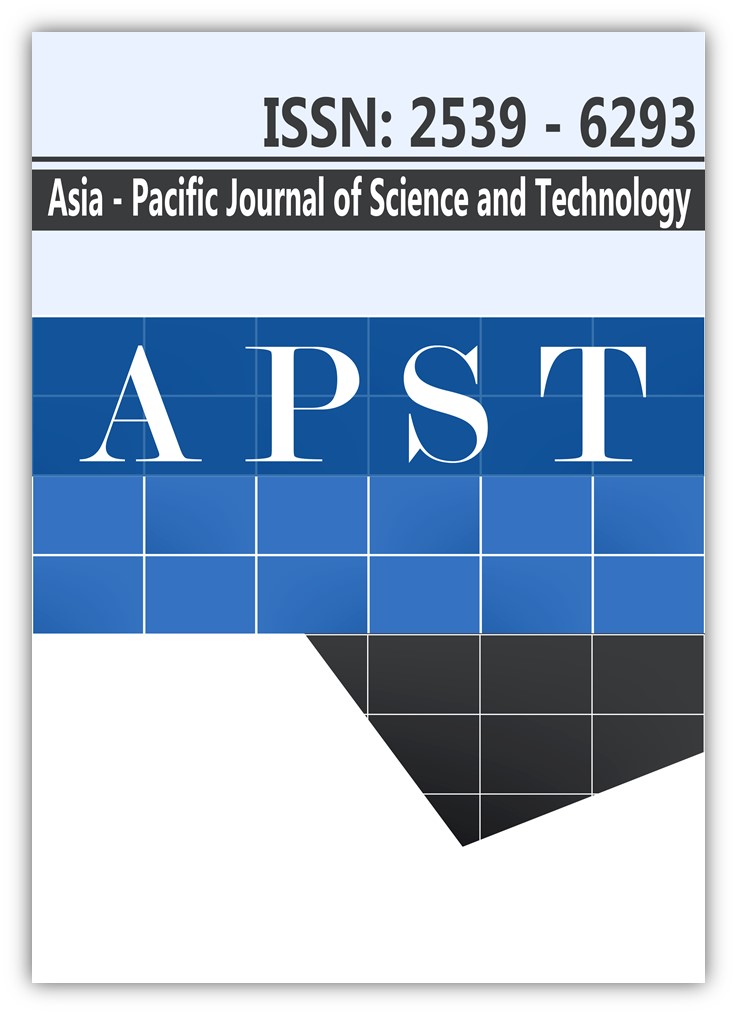Improving tenderness of breast meat of spent-laying hens using marination in alkaline or acidic solutions
Main Article Content
Abstract
The current usage of spent-laying hen meat has been limited due to the toughness and non-juicy texture of its cooked meat. The objective of this research was to improve tenderness of spent-laying hen breast meat using alkaline or acidic solutions. Three hundred pieces of spent-laying hen breast meat were randomly arranged into 10 treatments including control (no marination), marinating with distilled water, sodium bicarbonate (SBC) (0.10, 0.15, 0.20, and 0.25 M), and lactic acid (LA) (0.05, 0.10, 0.15, and 0.20 M). SBC increased (p < 0.05) the pH of raw and cooked meats, whereas LA decreased (p < 0.05) the pH of those meats. High concentration of SBC and LA decreased (p < 0.05) lightness values on the surface of the cooked meat. A decrease in shear force values (p < 0.05) was found in the cooked meats with margination due to an increase in water-holding capacity (WHC). Microscopic images of cooked meat illustrated the porous structure in SBC marinated meat. In addition, the clear gaps between each muscle fiber were observed in cooked LA marinated meat. Muscle fiber diameter of the marinated samples was greater (p < 0.05) than those of the control group, indicating the swelling of muscle in the marinated samples. Therefore, marinations with SBC and LA increased tenderness of the cooked meat by either increasing WHC or changing muscle structure of the meat. Based on the current findings, solutions of 0.10 M LA and 0.15 M SBC can be potential marinades for improving tenderness of spent-laying hen breast meat.
Article Details
References
[2] Lewis GJ, Purslow PP. The effect of marination and cooking on the technical properties of intramuscular connective tissue. J Muscle Foods. 1991;2:177-195.
[3] Archile-Contreras AC, Cha MC, Mandell IB, Miller SP, Purslow PP. Vitamins E and C may increase collagen turnover by intramuscular fibroblasts. Potential for improved meat quality. J Agric Food Chem. 2011;59:608-614.
[4] Wongwiwat P, Wattanachant S, Siripongvutikorn S. Effect of phosphate treatments on microbiological, physicochemical changes of spent hen muscle marinated with Tom Yum paste during chilled storage. J Sci Food Agric. 2010;90:1293-1299.
[5] Alvarado C, McKee S. Marination to improve functional properties and safety of poultry meat. J Appl Poult Res. 2007;16:113-120.
[6] Pearson AM, Tauber FW. Processed Meats. Westport: AVI; 1984.
[7] Gao T, Li1 J, Zhang L, Jiang Y, Ma R, Song L, Gao F, Zhou G. Effect of different tumbling marination treatments on the quality characteristics of prepared pork chops. Asian Austral J Anim. 2015;28:260-267.
[8] Parks SS, Reynolds AE, Wicker L. Aqueous apple flavoring in breast muscle has physical, chemical and sensory properties similar to those phosphate-marinated controls. Poult Sci. 2000;79:1183-1188.
[9] Lemos ALSC, Nunes DRM, Viana AG. Optimization of the still-marinating process of chicken parts. Meat Sci. 1999;52:227-234.
[10] Sheard PR, Nute GR, Richardson RI, Perry A, Taylor AA. Injection of water and polyphosphate into pork to improve juiciness and tenderness after cooking. Meat Sci. 1999;51:371-376.
[11] Nguyen HBSL, Gal R, Bunka F. Use of phosphates in meat products. Afr J Biotechnol. 2011;10:19874-19882.
[12] Yang HS, Moon SS, Jeong JY, Choi SG, Joo ST, Park GB. Effect of sodium bicarbonate injection in pre-rigor porcine M. Longissimus lumborum on pork quality. Asian Australas J Anim Sci. 2006;19:898-904.
[13] Petracci M, Laghi L, Rocculi P, Rimini S, Panarese V, Cremonini MA, Cavani C. The use of sodium bicarbonate for marination of broiler breast meat. Poult Sci. 2012;91:526-534.
[14] Ke S, Huang Y, Decker EA, Hultin HO. Impact of citric acid on the tenderness, microstructure and oxidative stability of beef muscle. Meat Sci. 2009;82:113-118.
[15] Ergezer H, Gokce R. Comparison of marinating with two different types of marinade on some quality and sensory characteristics of turkey breast meat. J Anim Vet Adv. 2011;10:60-67.
[16] Aktas N, Aksu MI, Kaya M. The effect of organic acid marination on tenderness, cooking loss and bound water content of beef. J Muscle Foods. 2003;14:181-194.
[17] Berge P, Ertbjerg P, Larsen LM, Astruc T, Vignon X, Møller AJ. Tenderization of beef by lactic acid injected at different times post mortem. Meat Sci. 2001;57:347-357.
[18] Qiao M, Fletcher DL, Smith DP, Northcutt JK. The effect of broiler breast meat color on pH, moisture, water-holding capacity, and emulsification capacity. Poult Sci. 2001;80:676-680.
[19] Association of Official Analytical Chemistry. Official methods of analysis of AOAC international. 17th ed. Maryland: CFR; 2000.
[20] Liu Y, Lyon BG, Windham WR, Realini CE, Pringle TDD, Duckett S. Prediction of color, texture, and sensory characteristics of beef steaks by visible and near infrared reflectance spectroscopy. Meat Sci. 2003;65:1107-1115.
[21] Wattanachant S, Benjakul S, Ledward DA. Effect of heat treatment on changes in texture, structure and properties of Thai indigenous chicken muscle. Food Chem. 2005;93:337–348.
[22] Choi YS, Choi JH, Han DJ, Kim HY, Lee MA, Kim HW, Jeong JY, Kim CJ. Characteristics of low-fat meat emulsion systems with pork fat replaced by vegetable oils and rice bran fiber. Meat Sci. 2009;82:266-271.
[23] Kim HY, Kim KJ, Lee JW, Kim GW, Choe JH, Kim HW, Yoon Y, Kim CJ. Quality characteristics of marinated chicken breast as influenced by the methods of mechanical processing. Korean J Food Sci Anim Resour. 2015;35:101-107.
[24] Sheard PR, Tali A. Injection of salt, tripolyphosphate, and bicarbonate marinade solutions to improve the yield and tenderness of cooked pork loin. Meat Sci. 2004;68:305-311.
[25] Sorheim O, Ofstad R, Lea P. Effects of carbon dioxide on yield, texture and microstructure of cooked ground beef. Meat Sci. 2004;67:231-236.
[26] Wynveen EJ, Bowker BC, Grant AL, Lamkey JW, Fennewand KJ, Henson L, Gerrard DE. Pork quality is affected by early postmortem phosphate and bicarbonate injection. J Food Sci. 2001;66:886-891.
[27] Hosseini SE, Esfahani Mehr A. The effect of meat marinating with lactic and citric acid on some physicochemical and electrophoretic pattern of beef burger. Iran J Vet Med. 2015;9:103-108.

